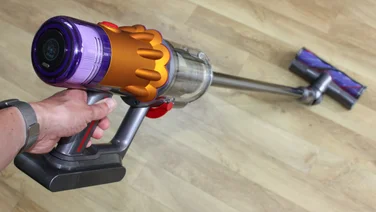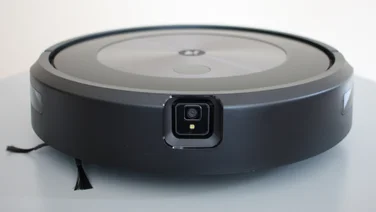To help us provide you with free impartial advice, we may earn a commission if you buy through links on our site. Learn more




























- Superior vacuuming
- Decent mopping
- Two tools in a single device
- Low on floor washing features
- Some mopping limitations
- Typically expensive
The Dyson V15s Detect Submarine is a new take on the familiar vacuum cleaner. It’s based on the Dyson V15 Detect, which I reviewed in 2021, delivering the same ultra-effective vacuuming for carpet and hard floor, but adding a third cleaning head: the Dyson Submarine for mopping.
This is a first for Dyson, because it makes its premium vacuum cleaner suitable for both dry vacuuming and floor mopping. All you do is add tap water to a reservoir in the new mopping floor head and that applies water to the roller to clean your floors more effectively.
Naturally, being a Dyson, the price is high, with the difference between a regular Dyson V15 Detect and this new V15s model being around £100. However, it’s a unique proposition, a first for Dyson, and offers a best-of-both-worlds solution to vacuuming and mopping.
Dyson V15s Detect Submarine review: What do you get for the money?
The Dyson V15s is a Dyson V15 Detect with an extra floor head, so what you get for your £800 isn’t all that different. The main vacuum unit operates as a handheld vacuum cleaner or a cordless stick vacuum and is identical to the regular V15. It has the same trigger control, colour screen and charging adapter.
The contents of the box mirror what you’d get if you bought a Dyson V15 Detect Absolute or Complete, too. This includes an extension wand, albeit with Submarine branding on it, the two dry floor heads – one for carpet, the other for hard floor – and three handheld attachments: a crevice tool, a motorised pet accessory and a multi-tool that can be a brush or a funnel.




























What your extra £100 gets you is the Submarine wet roller floor head. This is the largest head of the three, and is made up of a soft roller at the front, a water tank at the rear and an area that collects dirty water between the two.
Interestingly, this head doesn’t use the suction of the regular vacuum cleaner. The connection to the extension wand is sealed, so nothing can pass through the floor head and up into the collection bin. Instead, the motor is only used to power the roller.




























As a result, the mopping element of the Submarine isn’t quite as capable of tackling large, wet, chunky messes as dedicated hard floor cleaners such as the Shark HydroVac WD210UK or the Eufy Clean Mach V1 Ultra. The flip side, as you’ll find out from our test results below, is that it’s a far more effective all rounder.
By the way, if you’re a Dyson V15 Detect owner who is wondering whether they can get the wet floor head as a spare part and stick it onto their existing vacuum, the unfortunate answer is no. Dyson won’t be selling the floor head separately, and even if you could get hold of one, the software inside the vacuum has been updated to detect when the wet floor head is attached. This changes what’s displayed on the screen and switches off the regular suction, making the previous model incompatible.
READ NEXT: Best cordless vacuum cleaners
Dyson V15s Detect Submarine review: What’s it like to use?
Using the Dyson V15s Detect Submarine as a regular vacuum cleaner is exactly the same as using the previous V15. The main shortfall, which applies to all Dyson’s vacuums in the V series, is that to get the most effective cleaning on carpet and hard floor, you have to swap heads, where rival vacuums (the Shark Stratos IZ400UKT and Vax ONEPWR Blade 5 Dual Pet & Car, for instance) deliver effective cleaning in a single floor head.
If anything this inconvenience is exacerbated by the existence of the third Submarine head. Not only that but it needs filling with water before use, and you’re going to need to clean it out afterwards.To fill it you have to remove the outer casing of the floor head, unscrew the lid from the water reservoir and fill it with tap water. It can take 300ml of clean water. When you engage the device, by holding down the trigger on the main unit, water is sprayed across the length of the roller at a rate of 18ml per minute. That gives you around 16 minutes of cleaning time and it can cover an area of 110m2 before the reservoir needs refilling.
As the roller is depositing this water on the floor and using it to mop, it also lifts the liquid up and deposits it into a dirty water trough behind. No suction is involved but it’s a process that seems to work well, leaving the floor slightly damp, but free from puddles or pooling.




























It doesn’t feel quite like a vacuum in use, as the floor head is heavy and the fast spinning roller pulls the floor head forward when it’s engaged. That makes it slightly unbalanced when you pull it back but it isn’t terribly unwieldy.
By far the worst thing about using the Submarine head, however, is cleaning it out, which is a faff. Not only is it tricky to put back together once you’ve finished emptying it, but you have to wash out the roller by hand. Rival hard floor cleaners, such as the Shark HydroVac WD210UK and the Eufy Clean Mach V1 Ultra have stands that clean the roller through and charge the device.
READ NEXT: Best budget cordless vacuum cleaners
Dyson V15s Detect Submarine review: How well does it clean?
I’ve tested the V15 Detect before but I retested all elements of the vacuum again for this review. This was to check that Dyson hasn’t changed anything inside the vacuum to make it better or worse than it used to be, and I also wanted to test the vacuum with pet hair, because we weren’t performing pet hair tests when I reviewed the original.
Suction tests are tricky to perform with Dysons because they cut out and report a pipe blockage before they reach their maximum power. However, the suction we saw on this model before the vacuum cut-out matched what we’d seen in our tests of the regular V15 Detects.

To check out the cleaning power we test cordless stick vacuum cleaners with flour, Cheerios and pet hair, cleaning up measured spillages of each on both carpet and hard floor. By weighing the collection bin before and after a single pass over each spill, it’s possible to compare how well the vacuum performs against every other model we’ve tested.
In testing, the Dyson V15s matched the performance of the V15, Cheerio for Cheerio. In fact, its soft roller (for hard floor) put in a perfect performance in our tests, collecting 100% of everything I dropped.
On carpet, it wasn’t quite as good, with the carpet floor head tackling Cheerios slightly over vigorously, spitting out the occasional crumb and sending a small number of whole Cheerios flying off at an angle. It still collected 92% of the spill on a single pass, however, and the escapees didn’t last longer than a second pass.
Our flour spillage on short pile carpet is a tough test but, even here, the Dyson V15s was strong, collecting 94% on a single pass. A few more passes at different angles and there was nothing left on the floor.

I also took the opportunity to test the V15s in vacuum mode on pet hair, a test that we hadn’t developed when the original V15 Detect was reviewed. The clippings from the dog groomer’s floor didn’t stand a chance, though, with the vacuum easily collecting all the hair from both carpet and hard floor in a single pass.
When it comes to wet washing, I tested the cleaner on a patch of laminated floor, soiled with a muddy footprint, some undiluted blackcurrant squash and a squirt of tomato ketchup. To make it harder, I left the spills to dry before tackling them with the Submarine.




























Results were similar to what we’ve seen with other hard floor cleaners. The muddy footprint offered no resistance to the Dyson and was cleaned away in a single pass. The undiluted squash was a little harder, with most of it disappearing on the first pass, but its stubborn dry edges took three passes to remove.
As usual, the dry ketchup was the toughest test. This took 27 passes of the roller to lift the dried-on edges of the spill off the floor. This is a similar result to the Shark HydroVac WD210UK, which has the added benefit of a detergent mix. The Eufy Mach V1 Ultra removed this faster, but it has a steam option that helped get things moving even quicker.




























It’s worth noting, however, that the V15s isn’t as hardcore as these dedicated floor washers. It isn’t really configured to scoop up large spills, with only 360ml of space for gathered liquid, and Dyson suggests it won’t clean up particles much larger than crumbs. Still, it’s pretty good at basic mopping.
Dyson V15s Detect Submarine review: Should I buy it?
There’s a lot to like about the Dyson V15s Detect Submarine. It’s an excellent vacuum cleaner, offering the same performance as the equally capable V15 Detect and it’s a competent mopper, too, though dedicated hard-floor cleaning machines are a touch more effective.
If you’d prefer a standalone device then the Shark HydroVac WD210UK would be our first choice. It’s reasonable value for money, performs its job to a decent standard and comes with a stand that also charges the battery and rinses through the roller.
The Eufy Clean Mach V1 Ultra is another step up in terms of price and features, and comes with a handy steam function that does a good job of cleaning up more challenging stains.
However, it’s worth remembering that neither of these alternatives are particularly good vacuum cleaners. This means you either need to keep your old one or get a second device if you’re looking to upgrade. With the Dyson you get both vacuuming and floor mopping in a single device, and that makes it the best vacuum mop hybrid you can buy.






